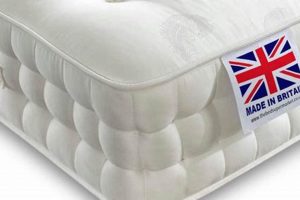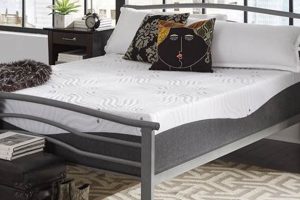The central subject addresses methods to increase the support provided by a sleep surface. This commonly involves altering the existing structure or supplementing it with materials that reduce sinkage and promote a more rigid feel. For example, placing a firm board between the mattress and bed frame or adding a dense mattress topper are common approaches.
Addressing mattress firmness is vital for proper spinal alignment and pressure point relief. A more supportive sleep surface can alleviate back pain, improve posture, and contribute to a more restful night’s sleep. Historically, the materials and construction techniques employed in mattress design have evolved to meet varying preferences for support and comfort.
The following sections will detail specific techniques and considerations for enhancing the support of a sleep surface, including the use of mattress toppers, platform adjustments, and considerations for different mattress types.
Enhancing Mattress Firmness
The following provides several actionable strategies to increase the support and reduce excessive give in an existing mattress.
Tip 1: Utilize a Mattress Topper. Select a firm mattress topper made of high-density foam or latex. These materials provide a robust surface that minimizes sinkage and distributes weight more evenly.
Tip 2: Employ a Bunkie Board. A bunkie board, a thin, flat piece of wood or plywood, placed directly beneath the mattress can create a more solid foundation, preventing sagging and increasing overall firmness.
Tip 3: Rotate or Flip the Mattress. Regular rotation (or flipping, if the mattress is double-sided) distributes wear and tear, preventing localized softening and maintaining a more consistent level of support.
Tip 4: Examine the Bed Frame. Ensure the bed frame provides adequate support. Slats should be closely spaced and sturdy. Consider replacing weak or damaged slats to prevent mattress sagging.
Tip 5: Adjust the Foundation. If the mattress sits on a box spring, consider replacing it with a solid platform foundation. Platform foundations offer increased support and minimize movement.
Tip 6: Use a Mattress Encasement. While primarily for protection, a tightly fitted mattress encasement can add a subtle layer of firmness by compressing the mattress fibers.
Tip 7: Control Room Temperature. Extreme temperatures can affect the materials of the mattress. Keeping the room temperature moderate may help maintain the original firmness.
Implementing these strategies can noticeably improve the support of a mattress, leading to improved spinal alignment and reduced discomfort.
The concluding section will address considerations for selecting a new, firmer mattress when existing methods prove insufficient.
1. Support Enhancement
Support Enhancement constitutes a core element in altering the firmness of a sleep surface. It encompasses methods designed to reduce sinkage and provide a more stable foundation for the sleeper. Understanding these methods is crucial in the pursuit of a firmer mattress.
- Foundation Reinforcement
Foundation reinforcement involves bolstering the base upon which the mattress rests. This can include replacing weak or damaged slats in a bed frame, using a bunkie board to provide a solid surface beneath the mattress, or switching from a traditional box spring to a platform foundation. A stable foundation prevents sagging and distributes weight more evenly, contributing to perceived and actual firmness. For example, placing a sheet of plywood between a sagging box spring and mattress can provide noticeable support. The stability of the foundation critically influences the overall feel and firmness of the sleep surface.
- Topper Implementation
The addition of a mattress topper crafted from high-density materials, such as latex or high-density foam, represents a direct method of support enhancement. These toppers function as an intermediary layer, minimizing sinkage into the underlying mattress. The density of the topper material directly correlates with the level of support provided. A 3-inch high-density latex topper, for example, will significantly increase the firmness compared to a thinner, less dense memory foam option. This approach directly addresses the surface comfort without altering the original mattress.
- Internal Support Augmentation
While less accessible to the average consumer, some mattresses allow for the augmentation of internal support structures. This might involve adding additional coils to a coil-based mattress or reinforcing the foam core of a foam mattress. Though often a task best left to professionals, understanding the internal architecture of a mattress allows for targeted support enhancement. For example, adding edge support foam can reduce edge sagging and increase the usable surface area of the mattress with enhanced firmness.
- Proper Weight Distribution Techniques
Although not strictly a physical alteration, promoting even weight distribution through regular mattress rotation and, where applicable, flipping, contributes to perceived support enhancement. These practices prevent localized wear and tear, ensuring that no single area of the mattress softens prematurely. By distributing body weight evenly, these techniques help maintain a consistent level of support across the entire sleep surface, thus maximizing its lifespan and firmness. For instance, rotating a mattress every three months helps prevent indentations from forming in the areas where the most weight is concentrated.
These facets of Support Enhancement are interdependent and contribute collectively to the firmness of a mattress. The effectiveness of any single method is often contingent on the condition and type of mattress being addressed. Each approach offers varying degrees of improvement, and the optimal strategy often involves a combination of techniques to achieve the desired level of firmness and support. The ultimate objective is to provide a sleep surface that promotes proper spinal alignment and pressure point relief.
2. Foundation Stability
Foundation stability is a crucial element in achieving a firmer mattress. A structurally sound foundation directly impacts the perceived and actual firmness of the sleep surface. An unstable foundation, conversely, undermines efforts to increase mattress firmness. The cause-and-effect relationship is straightforward: a weak or damaged foundation allows the mattress to sag, negating any attempts to add support through toppers or other means. The importance of foundation stability stems from its role as the base upon which all other firmness-enhancing strategies depend. Consider a scenario where a high-density latex topper is placed on a mattress su
pported by a broken box spring. The topper’s inherent firmness is diminished because the underlying foundation fails to provide adequate support, resulting in localized sinking and overall instability. This highlights the principle: no mattress, regardless of its construction, will maintain its intended firmness if the foundation is compromised.
Practical implications of understanding foundation stability are numerous. Prior to investing in a new mattress or firmness-enhancing products, a thorough inspection of the existing foundation is paramount. This includes checking for broken or warped slats, sagging springs in a box spring, and overall structural integrity. If the foundation exhibits signs of weakness, it should be repaired or replaced. Options range from reinforced bed frames with closely spaced slats to platform beds that provide a solid, unwavering surface. For example, replacing a traditional box spring with a platform bed frame immediately increases the support level, preventing mattress deformation and contributing to a firmer sleep experience. Furthermore, specialized adjustable bases, designed to contour to the sleeper’s body, also necessitate a stable and robust construction to maintain both their adjustability and overall support.
In summary, foundation stability is inextricably linked to the endeavor of achieving a firmer mattress. Neglecting this aspect renders other attempts at firmness enhancement less effective. The key insight is that the foundation serves as the fundamental support structure, and its integrity directly translates into the performance and longevity of the mattress. Addressing foundation issues proactively is a crucial step in optimizing sleep quality and maximizing the lifespan of the mattress. Any challenges encountered in achieving desired firmness should begin with a rigorous evaluation of the existing foundation, ensuring it is structurally sound and capable of providing the necessary support.
3. Topper Selection
Topper selection represents a critical component in modifying a mattress’s firmness. The direct effect of a topper on the sleep surface is readily apparent: a firmer topper invariably increases the overall support provided. The importance of topper selection lies in its accessibility and relatively low cost compared to replacing an entire mattress. Consider the scenario of an individual experiencing back pain attributed to an overly soft mattress. Rather than purchasing a new mattress, a judiciously chosen firm latex topper can provide the necessary support to alleviate discomfort. This illustrates the practical significance of understanding the connection between topper selection and achieving a firmer sleep surface. The density, material composition, and thickness of the topper are all determining factors in the level of firmness achieved. For example, a high-density memory foam topper will generally provide less support than a comparable latex topper due to its conforming properties. The correct topper selection is contingent upon the individual’s weight, sleeping position, and the existing properties of the mattress.
Further analysis reveals the nuanced considerations involved in topper selection. The market offers a diverse array of topper materials, each with distinct firmness characteristics. Latex toppers are recognized for their resilience and responsiveness, providing a firm and supportive surface. Memory foam toppers conform to the body, offering pressure relief but potentially compromising support. Wool and feather toppers offer minimal firmness enhancement and primarily contribute to comfort and temperature regulation. Therefore, a deliberate approach to material selection is essential. To illustrate, an individual seeking a firmer mattress to alleviate back pain would benefit more from a firm latex topper than a plush memory foam option. Practical applications extend to customizing the feel of different areas of the mattress. For couples with differing firmness preferences, a topper can be used on one side of the bed to accommodate individual needs.
In conclusion, topper selection is a significant factor in achieving a desired mattress firmness level. The key insight is the deliberate matching of topper properties to the individual’s needs and the existing mattress characteristics. Challenges in topper selection often arise from a lack of understanding regarding material properties and firmness levels. By carefully considering these factors, individuals can effectively modify their sleep surface and optimize their comfort and support. Topper selection presents a tangible and adjustable approach to address varying firmness preferences. It offers a targeted solution for improved sleep quality and spinal alignment, without necessitating a full mattress replacement.
4. Material Density
Material density plays a critical role in determining the firmness of a mattress. It is a fundamental property directly influencing the level of support provided and the overall feel of the sleep surface. Understanding the relationship between material density and firmness is essential when seeking ways to modify a mattress for enhanced support.
- Foam Density and Firmness
The density of foam, whether memory foam, polyurethane foam, or latex foam, is a primary determinant of its firmness. Higher density foams contain more material per unit volume, resulting in greater resistance to compression. This increased resistance translates directly to a firmer feel and enhanced support. For example, a high-density memory foam topper will provide more support and less sinkage than a low-density memory foam topper, even if both have the same ILD (Indentation Load Deflection) rating. The increased density contributes to a more stable and supportive sleep surface.
- Coil Count and Wire Gauge
For innerspring mattresses, coil count and wire gauge are analogous to density in foam mattresses. A higher coil count signifies a greater concentration of coils within the mattress core, leading to increased support and reduced motion transfer. Similarly, a lower wire gauge (thicker wire) indicates a sturdier coil that resists compression more effectively, contributing to a firmer feel. A mattress with a high coil count and low wire gauge will generally provide a firmer and more supportive sleeping surface than one with fewer coils and a higher wire gauge. The arrangement and tempering of the coils also factor into overall support and durability.
- Latex Density Variations
Latex mattresses offer varying levels of firmness based on density and manufacturing process (Dunlop or Talalay). Dunlop latex, generally denser than Talalay, provides a firmer and more durable support. The higher density of Dunlop latex results from the complete filling of the mold during manufacturing, leading to a denser and more resilient core. Conversely, Talalay latex undergoes a vacuum process that results in a lighter and less dense product. While Talalay may offer greater comfort and pressure relief, Dunlop latex typically provides enhanced support and firmness. This distinction is crucial when selecting a latex mattress or topper for increased firmness.
- Material Composition and Blends
The blend of materials within a mattress or topper also affects its density and, consequently, its firmness. For instance, a memory foam mattress infused with gel particles may exhibit a different density profile than a traditional memory foam mattress. The a
ddition of gel particles can alter the foam’s compression characteristics and affect its overall firmness. Similarly, hybrid mattresses that combine foam and coil layers must carefully balance the density of each material to achieve a desired level of support and comfort. The interplay between different material densities is a key consideration in mattress design and performance.
These aspects of material density are interconnected and critical for achieving desired mattress firmness. Higher density generally equates to greater support and reduced sinkage, but the specific properties of the material and its construction also play significant roles. Understanding these relationships allows for informed decisions when seeking to enhance the firmness of a sleep surface, whether through the selection of a new mattress or the addition of a topper.
5. Even Weight Distribution
Even weight distribution significantly impacts the perceived and actual firmness of a mattress. Uneven distribution leads to localized compression and sagging, diminishing support and compromising firmness, regardless of the mattress’s initial design. Addressing weight distribution is, therefore, integral to maintaining and enhancing mattress firmness.
- Regular Mattress Rotation and Flipping
Consistent rotation, and flipping where applicable, is a fundamental practice. Rotating the mattress ensures that wear and tear are distributed across the entire surface, preventing localized depressions from forming where the sleeper typically rests. Flipping, on mattresses designed for double-sided use, exposes the less-used side, allowing the compressed materials to recover and extending the mattress’s lifespan. The frequency of rotation or flipping depends on mattress type and construction, but quarterly adjustments are generally recommended. A noticeable indentation where a sleeper habitually lies is a clear indicator of insufficient rotation or flipping.
- Optimizing Bed Frame and Foundation Support
A bed frame and foundation providing inadequate support contribute directly to uneven weight distribution. Sagging slats or a weakened box spring create localized areas of increased compression, leading to premature wear in those areas. Ensuring that the bed frame and foundation are structurally sound and capable of evenly supporting the mattress is crucial. Upgrading to a platform bed or reinforcing existing bed frames can significantly improve weight distribution and maintain firmness. This is particularly important for heavier individuals or couples.
- Strategic Use of Mattress Toppers
While often used to increase overall firmness, mattress toppers can also be strategically employed to improve weight distribution. A topper made of high-density foam can redistribute weight more evenly across the underlying mattress, mitigating the effects of localized compression. Selecting a topper with zonal support, featuring varying densities across different areas, can further enhance weight distribution by providing targeted support to specific regions of the body. However, a worn-out topper can contribute to weight concentration issues.
- Addressing Uneven Floor Surfaces
The floor upon which the bed frame rests significantly impacts weight distribution. An uneven floor surface can cause the bed frame and mattress to tilt, concentrating weight on certain areas and leading to premature wear and sagging. Ensuring that the bed frame is level on the floor is essential. This can be achieved by using shims or leveling feet to compensate for uneven surfaces. Neglecting this factor can negate even the most diligent efforts to maintain mattress firmness.
These facets underscore the importance of even weight distribution in maintaining and enhancing mattress firmness. Addressing these issues proactively, through regular rotation, proper foundation support, strategic topper use, and floor surface corrections, can significantly prolong the lifespan of the mattress and ensure consistent support across the entire sleep surface. The correlation is direct: more even distribution leads to greater and more sustained firmness.
6. Temperature Influence
Temperature significantly affects the properties of mattress materials, thereby influencing its firmness. Fluctuations in temperature can cause materials like memory foam and latex to either soften or stiffen, impacting the support provided and overall sleep experience. High temperatures generally soften these materials, leading to increased sinkage and a reduction in perceived firmness. Conversely, lower temperatures can cause them to become more rigid, increasing the resistance to compression and making the mattress feel firmer. The degree of temperature sensitivity varies based on material composition and density.
The practical implications of temperature influence extend to environmental control and material selection. Maintaining a consistent room temperature can mitigate the impact of temperature fluctuations on mattress firmness. Using a mattress encasement can also provide a degree of insulation, stabilizing the mattress temperature. Furthermore, certain mattress materials are less susceptible to temperature changes. For example, innerspring mattresses are less affected by temperature than memory foam mattresses. During warmer months, memory foam mattress owners might notice their bed softens compared to its state during cooler seasons. Selecting a mattress material with lower temperature sensitivity can help ensure a more consistent firmness level throughout the year. This is particularly relevant for individuals residing in regions with significant temperature variations.
In summary, temperature plays a modulating role in mattress firmness by affecting the physical properties of its constituent materials. Implementing temperature control measures and selecting less temperature-sensitive materials are strategies to maintain a consistent level of support. The interaction between temperature and mattress materials underscores the complexity of achieving a desired firmness level and the importance of considering environmental factors alongside material selection. Challenges arise when controlling ambient temperature proves difficult, but understanding this influence is crucial for optimizing the sleep experience.
7. Structural Integrity
Structural integrity is paramount in preserving and enhancing the firmness of a mattress. The degree to which a mattress maintains its intended shape and support under load directly influences its perceived and actual firmness. Compromised structural integrity undermines any efforts to increase or maintain firmness through external means.
- Core Support System Degradation
Degradation of the core support system, whether coil-based or foam-based, directly impacts mattress firmness. In coil mattresses, broken or weakened coils result in localized sagging and reduced support. In foam mattresses, compression set and foam fatigue lead to a loss of resilience and a softening of the overall surface. For instance, a mattress with broken coils in the lumbar region will provide inadequate su
pport, regardless of any topper added. This core degradation ultimately diminishes the overall firmness and compromises spinal alignment. - Edge Support Deterioration
Deterioration of edge support structures contributes to a loss of usable sleep surface and reduces overall mattress stability. Weakened edges cause the mattress to sag along the perimeter, making it difficult to sleep comfortably near the edge and impacting the perceived firmness of the entire surface. The implementation of stronger edge support systems, such as reinforced coils or high-density foam encasements, is crucial for maintaining structural integrity and preventing edge sagging. Edge support failure demonstrates the importance of a cohesive structural design.
- Upholstery and Ticking Compromise
Damage to the upholstery and ticking, the outer layers of the mattress, can compromise the structural integrity of the entire unit. Rips, tears, or excessive stretching of these layers can allow internal materials to shift and deform, leading to uneven support and reduced firmness. A damaged ticking can also expose the internal materials to moisture and contaminants, accelerating their degradation. Maintaining the integrity of these outer layers is essential for protecting the internal components and preserving the overall firmness of the mattress.
- Foundation Mismatch and Resulting Stress
Using a foundation that is incompatible with the mattress type can induce undue stress on the internal components, leading to structural damage and reduced firmness. For example, placing a memory foam mattress on a traditional box spring with widely spaced coils can create uneven pressure points, causing premature sagging and foam degradation. Selecting a foundation that provides adequate and consistent support across the entire mattress surface is crucial for preserving its structural integrity and maintaining its intended firmness. The foundation serves as the bedrock for structural soundness.
These facets of structural integrity are interdependent and collectively determine the long-term firmness and support of a mattress. Addressing each aspect proactively, from selecting durable materials to using a compatible foundation, is crucial for maximizing the lifespan of the mattress and ensuring consistent performance. Compromised structural integrity inevitably leads to a reduction in firmness and necessitates either repair or replacement of the affected components, further underscoring the critical link between structural integrity and the ability to effectively enhance or maintain mattress firmness.
Frequently Asked Questions
The following addresses common inquiries regarding methods to increase the support and reduce the softness of a mattress.
Question 1: Can a mattress topper truly increase firmness, or is it merely a surface comfort layer?
A mattress topper’s ability to increase firmness depends on its material composition and density. High-density latex or firm memory foam toppers can significantly enhance support and reduce sinkage. Low-density or plush toppers primarily provide comfort and may not substantially increase firmness.
Question 2: How does foundation type impact the effectiveness of firmness-enhancing strategies?
The foundation’s stability directly influences the success of any attempt to increase mattress firmness. A weak or damaged foundation allows the mattress to sag, negating the benefits of toppers or other support enhancements. A solid platform foundation is generally recommended for optimal support.
Question 3: Is there a correlation between mattress age and the ability to improve firmness?
Yes, the age of the mattress is a significant factor. An older mattress with significant internal wear may not respond effectively to firmness-enhancing techniques. The degradation of internal support structures can limit the effectiveness of external adjustments. Replacement may be necessary in such cases.
Question 4: What role does body weight play in determining the appropriate firmness adjustments?
Body weight directly influences the amount of support required from a mattress. Individuals with higher body weights necessitate firmer support to prevent excessive sinkage and maintain proper spinal alignment. Higher-density materials and more robust support systems are typically required for heavier individuals.
Question 5: Are there specific types of mattresses that respond better to firmness adjustments?
Generally, innerspring and hybrid mattresses may respond more favorably to firmness adjustments compared to all-foam mattresses. The coil-based support systems in these mattresses often provide a more stable foundation for toppers and other support enhancements. However, the specific construction of each mattress significantly influences its responsiveness.
Question 6: Can temperature affect the perceived firmness of a mattress, and if so, how can this be managed?
Yes, temperature can influence the properties of certain mattress materials, particularly memory foam. Higher temperatures tend to soften memory foam, while lower temperatures can make it firmer. Maintaining a consistent room temperature can mitigate these effects. The implementation of specialized mattress protectors or encasements can also help insulate the mattress from extreme temperature fluctuations.
Effective adjustment of mattress firmness involves a careful evaluation of the mattress type, foundation, age, and individual needs. A holistic approach, considering all these factors, is crucial for achieving the desired level of support and comfort.
The subsequent section will provide a summary of best practices for achieving a firmer sleep surface.
Conclusion
The preceding exploration of “how to make a mattress more firm” has detailed actionable strategies, encompassing foundation stabilization, topper selection based on material density, even weight distribution techniques, and awareness of temperature influence on materials. Enhancing structural integrity is paramount for long-term firmness and support. These elements work in concert to provide a more supportive sleep surface.
Ultimately, achieving the desired level of mattress firmness is a multifaceted endeavor, requiring careful consideration of numerous interconnected factors. The pursuit of improved sleep quality through firmness adjustments demands a comprehensive understanding of mattress construction, material properties, and individual needs. When attempts to modify existing mattress firmness prove insufficient, a thorough reevaluation of sleep support systems, including the mattress itself, is warranted to ensure optimal spinal alignment and restorative rest.





![KC Mattress Firm Warehouse: [Deals & More] Organic & Natural Mattress Buyer’s Guide: Non-Toxic Sleep Solutions KC Mattress Firm Warehouse: [Deals & More] | Organic & Natural Mattress Buyer’s Guide: Non-Toxic Sleep Solutions](https://mattressworldpa.com/wp-content/uploads/2025/07/th-8965-300x200.jpg)

